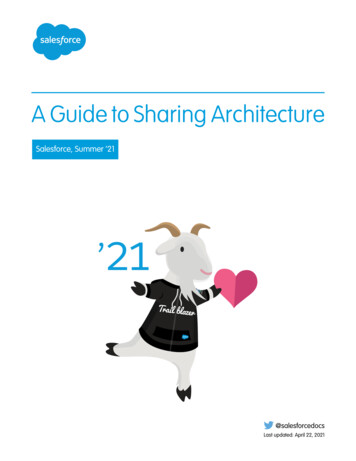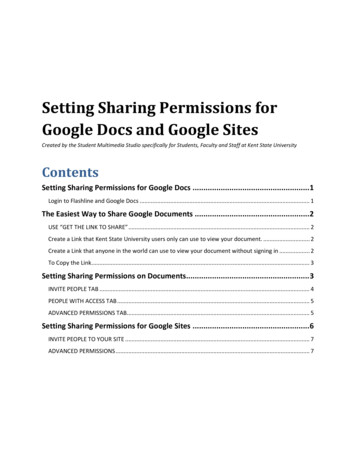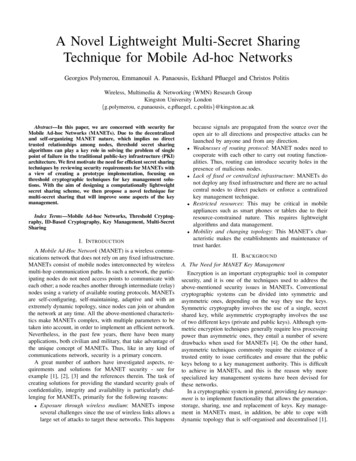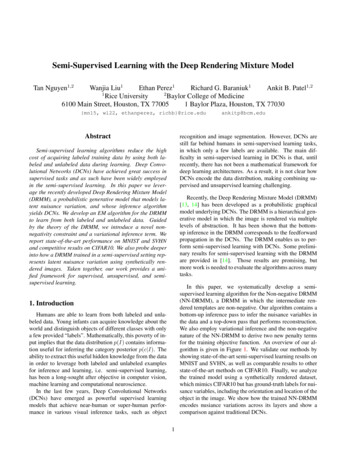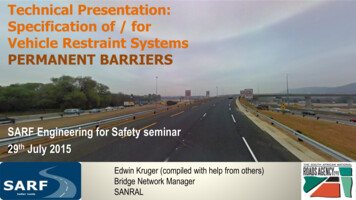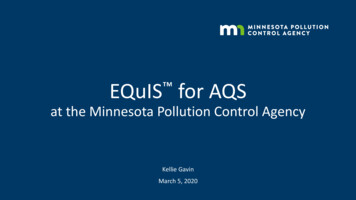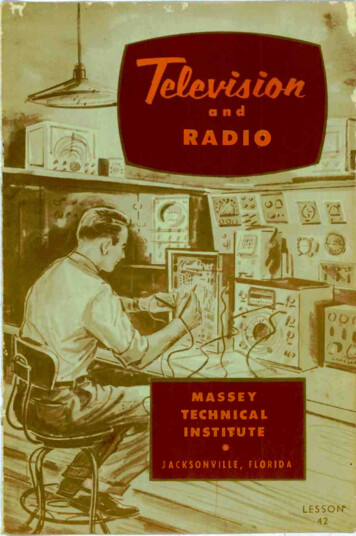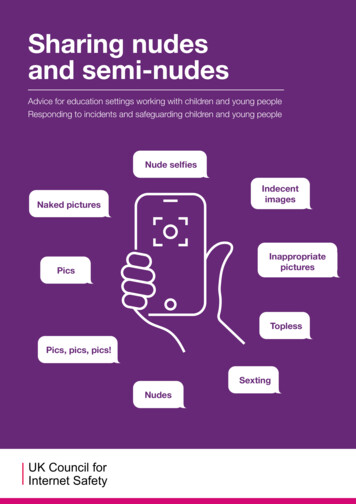
Transcription
Sharing nudesand semi-nudesAdvice for education settings working with children and young peopleResponding to incidents and safeguarding children and young peopleNude selfiesIndecentimagesNaked picturesInappropriatepicturesPicsToplessPics, pics, pics!SextingNudesUK Council forInternet Safety
DisclaimerRelevant laws and best practice have been taken into account in the development ofthis document. However, these issues have the potential to be complex and multifaceted. As case law in this area is still relatively underdeveloped, nothing in thisdocument should be taken as legal advice.The authors and other contributors to this document accept no liability for any damageor loss suffered or incurred whether directly, consequentially, indirectly or otherwise byanyone relying on the information in this publication or any other information referred toin it.Web addresses, social networks, apps and other references in this document werecorrect at the time of publication but may be subject to change over time.This document was last updated and published in December 2020.Production of this document has been coordinated by the UK Council for Internet Safety’s EducationWorking Group in partnership with the NPCC.
CONTENTSSECTION ONE – BACKGROUND AND CONTEXT. 41.1 Who is this for? . 41.2 What does this advice cover? . 41.3 What is the status of this advice? . 51.4 ‘Sharing nudes and semi-nudes’: definition. 61.4(a) Alternative definitions . 71.5 Why does this matter to settings working with children? . 71.6 Understanding motivations and behaviours . 81.6(a) Defining the incident . 91.6(b) Assessing behaviour .101.7 The law .121.7(a) Indecent images of children .121.7(b) Non-consensual image sharing.131.8 Avoiding unnecessary criminalisation of children .131.9 The police response .131.9(a) Crime recording .141.9(b) Police decision .141.9(c) Criminal records check.151.9(d) Multi-agency working .16SECTION TWO – HANDLING INCIDENTS . 172.1 Initial response .172.2 Disclosure.182.3 Initial review meeting .192.4 Assessing the risks .202.5 Supporting the young person/people involved .212.6 Informing parents and carers .242.7 Supporting parents and carers.242.8 Multi-agency working .272.9 Children’s social care contact and referrals .282.10 Searching devices, viewing and deleting nudes and semi-nudes .28
2.10(a) Viewing the imagery.282.10(b) Deletion of imagery .302.11 Recording incidents .312.12 Reporting nudes and semi-nudes online .312.13 Best practice responses to incidents.31SECTION THREE – EDUCATING CHILDREN AND YOUNG PEOPLE . 353.1 Why educate children and young people about the sharing of nudes and semi-nudes? .353.2 When and where should we teach children and young people about the sharing of nudesand semi-nudes? .353.3 How can we deliver education safely? .373.4 Using external visitors.383.5 What resources are available? .39Annex A: Questions to support assessment . 41Annex B: Training exercise . 46Annex C: Table of substantive changes from Sexting in Schools and Colleges . 553
SECTION ONE – BACKGROUND AND CONTEXT1.1 Who is this for?This advice is for designated safeguarding leads (DSLs), their deputies, headteachersand senior leadership teams in schools and educational establishments 1 in England.Other members of staff should see a one-page summary on how to manage incidentsavailable on the UK Council for Internet Safety’s (UKCIS’) website.This document may also act as good practice advice for out-of-school settings providingeducation for children and young people in England e.g. extracurricular clubs, youthorganisations and providers.Practitioners working in education settings in Wales should see the following advice onresponding to incidents: Sharing nudes and semi-nudes: responding to incidents and safeguardingchildren and young people (Welsh Government as part of UKCIS)Practitioners working in education settings in Scotland should see the followingguidance and advice for responding to incidents and safeguarding children and youngpeople in Scotland: National Guidance for Child Protection in Scotland (Scottish Government) 2 Healthy relationships and consent: key messages for young people (ScottishGovernment) Upstream (Stop It Now! and the Scottish Government) What’s the problem? (Stop It Now!) Internet safety for children and young people: national action plan (ScottishGovernment)1.2 What does this advice cover?This advice outlines how to respond to an incident of nudes and semi-nudes beingshared (see section 1.4 for a definition), including:1 risk assessing situations safeguarding and supporting children and young people handling devices and images recording incidents, including the role of other agencies‘Schools and educational establishments’ refers to schools and colleges and includes: maintainedschools and colleges, independent schools (including academies, free schools), alternative provisionacademies and non-maintained special schools and Pupil Referral Units.2 Currently under review and due to be published in 20214
informing parents and carersThe types of incidents which this advice covers are: a person under the age of 18 creates and shares nudes and semi-nudes ofthemselves with a peer under the age of 18 a person under the age of 18 shares nudes and semi-nudes created by anotherperson under the age of 18 with a peer under the age of 18 a person under the age of 18 is in possession of nudes and semi-nudes createdby another person under the age of 18This advice does not cover: the sharing of nudes and semi-nudes of under 18s by adults (18 and over) as thisconstitutes child sexual abuse and education settings should always inform theirlocal police force as a matter of urgency3 children and young people under the age of 18 sharing adult pornography orexchanging sexual texts which do not contain imagesIn response to these issues, education settings should follow their local authority’sguidance and schools and colleges should also refer to the Department for Education’s(DfE’s) Keeping Children Safe in Education statutory safeguarding guidance.1.3 What is the status of this advice?The production of this advice has been co-ordinated by the UKCIS Education WorkingGroup in consultation with the National Police Chiefs' Council (NPCC) on behalf ofUKCIS.This advice is non-statutory, and schools and colleges should read this alongside: Keeping Children Safe in Education statutory guidance (DfE) Sexual violence and sexual harassment between children in schools andcolleges non-statutory advice (DfE) Searching, Screening and Confiscation non-statutory advice (DfE).The advice replaces ‘Sexting in schools and colleges: responding to incidents andsafeguarding young people’ published in 2016 by UKCIS in collaboration with the NPCCand Charlotte Aynsley.This also includes instances where a person under the age of 18 shares nudes or semi-nudes createdby a peer under the age of 18 with an adult35
1.4 ‘Sharing nudes and semi-nudes’: definitionThis advice uses the term ‘sharing nudes and semi-nudes’ to mean the sending orposting of nude or semi-nude images, videos or live streams by young people under theage of 18 online. This could be via social media, gaming platforms, chat apps or forums.It could also involve sharing between devices via services like Apple’s AirDrop whichworks offline.The term ‘nudes’ is used as it is most commonly recognised by young people and moreappropriately covers all types of image sharing incidents. Alternative terms used bychildren and young people may include ‘dick pics’ or ‘pics’.The motivations for taking and sharing nude and semi-nude images, videos and livestreams are not always sexually or criminally motivated. Such images may be createdand shared consensually by young people who are in relationships, as well as betweenthose who are not in a relationship. 4 It is also possible for a young person in aconsensual relationship to be coerced into sharing an image with their partner. Incidentsmay also occur where: children and young people find nudes and semi-nudes online and share themclaiming to be from a peer children and young people digitally manipulate an image of a young person intoan existing nude online images created or shared are used to abuse peers e.g. by selling images onlineor obtaining images to share more widely without consent to publicly shameFurther guidance on the motivations for taking and sharing images and videos can befound in section 1.6.The sharing of nudes and semi-nudes can happen publicly online, in 1:1 messaging orvia group chats and closed social media accounts.Nude or semi-nude images, videos or live streams may include more than one child oryoung person.Creating and sharing nudes and semi-nudes of under-18s (including those created andshared with consent) is illegal which makes responding to incidents involving childrenand young people complex. There are also a range of risks which need carefulmanagement from those working in education settings.4 Consent is defined as an agreement made by choice, whereby an individual has the freedom andcapacity to make that choice. This is outlined in s.74 of the Sexual Offences Act 2003. This mean thechild or young person must have the capacity (i.e. the age and understanding) to make the choice and bein the position to make that choice freely without exploitation, threat or fear.6
1.4(a) Alternative definitionsMany professionals may refer to ‘nudes and semi-nudes’ as: youth produced sexual imagery or ‘youth involved’ sexual imagery indecent imagery. This is the legal term used to define nude or semi-nudeimages and videos of children and young people under the age of 18. Furtherguidance on the law can be found in section 1.7 ‘sexting’. Many adults may use this term, however some young people interpretsexting as ‘writing and sharing explicit messages with people they know’ ratherthan sharing images image-based sexual abuse. This term may be used when referring to the nonconsensual sharing of nudes and semi-nudes5Terms such as ‘revenge porn’ and ‘upskirting’ 6 are also used to refer to specificincidents of nudes and semi-nudes being shared. However, these terms are more oftenused in the context of adult-to-adult non-consensual image sharing offences outlined ins.33-35 of the Criminal Justice and Courts Act 2015, Voyeurism (Offences) Act 2019and s.67A of the Sexual Offences Act 2003.1.5 Why does this matter to settings working with children?Sharing photos, videos and live streams online is part of daily life for many people,enabling them to share their experiences, connect with friends and record their lives.Photos and videos can be shared via messaging apps or posted on social media andimage sharing platforms. It is important to note that children and young people send avariety of images and videos, some of which are not nude, semi-nude and/orexploitative or intended to be so. However, the focus of this guidance is on the sendingof nudes and semi-nudes.Although many education settings are dealing with an increase in incidents of nudesand semi-nudes being shared, research has found a significant number of children andyoung people aren’t sending or receiving nudes and semi-nudes (Brook and NCACEOP, 2017): 26% had sent a nude image to someone they were interested in 48% had received one of someone else, sent by that same person5 Online Sexual Harassment: Comprehensive Guidance for Education settings, School of SexualityEducation et al, 2020. Available at: https://schoolofsexed.org/guidance-for-schools6 ‘Upskirting’ is where someone takes a picture under a person’s clothing (not necessarily a skirt) withouttheir permission and/or knowledge, with the intention of viewing their genitals or buttocks (with or withoutunderwear) to obtain sexual gratification, or cause the victim humiliation, distress or alarm. It is a criminaloffence and anyone of any gender can be a victim.7
Although most children and young people aren’t creating or sharing these types ofimages and videos, the potential risks are significant. If the imagery is shared further, itmay lead to embarrassment, bullying and increased vulnerability to blackmail andexploitation.Producing and sharing nudes and semi-nudes of under 18s is also illegal, which causesconsiderable concern in education settings working with children and young people, andamongst parents and carers.Although the production of such images will likely take place outside of educationsettings, sharing can take place and issues are often identified or reported here.Education settings need to be able to respond swiftly and confidently to make surechildren and young people are safeguarded, supported and educated.This advice aims to support education settings in developing procedures to respond toincidents involving nudes and semi-nudes. It also signposts sources of resources andsupport.These procedures should be part of an education setting’s safeguarding arrangementsand all incidents should be dealt with as safeguarding concerns.The response to these incidents should be guided by the principle of proportionality andthe primary concern at all times should be the welfare and protection of any childrenand young people involved.Individual incidents of peer abuse and sexual behaviour (the sharing of nudes and seminudes can fall under this category) can lead to unhealthy or damaging cultures withinthe school community. How these incidents – including incidents of ‘low level’ harmfulsexual behaviour – are responded to directly affects the culture of the school. If handledpoorly, an unsafe and unhealthy set of norms can be created which enable peer-onpeer abuse and this can also prevent other children and young people from disclosing.It must be recognised that the individual case management can affect school-wideculture, peer response and all children’s ability to speak out.1.6 Understanding motivations and behavioursNudes and semi-nudes can be shared by, and between, children and young peopleunder a wide range of circumstances, and are often not sexually or criminally motivated.An education setting’s response to an incident will differ depending on the motivationsbehind the incident and the appropriateness of the child or young person’s/people’sbehaviour.8
In order to ensure an appropriate and proportionate response to an incident of nudesand semi-nudes being shared, education settings can use the tools set out below.1.6(a) Defining the incidentFinkelhor and Wolak’s typology of youth-produced imagery cases can be used to defineand assess incidents according to motivations. 7Incidents can broadly be divided into two categories: aggravated: incidents involving additional or abusive elements beyond thecreation, sending or possession of nudes and semi-nudes. These can further besub-categorised into:o adult involved: adult offenders attempt to develop relationships bygrooming children and young people, in criminal sex offences evenwithout the added element of nudes and semi-nudes. Victims may befamily friends, relatives, community members or contacted via the Internet.The images may be solicited by adult offenderso youth only – intent to harm: these cases can arise from interpersonalconflict, such as break-ups and fights among friends, or criminal/abusiveconduct such as blackmail, threats or deception, sexual abuse orexploitation by young peopleo youth only – reckless misuse: no intent to harm but images are taken orsent without the knowing or willing participation of the young person whois pictured. In these cases, pictures are taken or sent thoughtlessly orrecklessly and a victim may have been harmed as a result experimental: incidents involving the creation and sending of nudes and seminudes with no adult involvement, no apparent intent to harm or reckless misuse.These can further be subcategorised into:o romantic: incidents in which young people in ongoing relationships makeimages for themselves or each other, and images were not intended to bedistributed beyond the pairo ‘sexual attention seeking’: the phrase ‘sexual attention seeking’ is takendirectly from the typology however it is important to note that incidentswithin this category can be a part of normal childhood. A child or youngperson should not be blamed for taking and sharing their imageo other: cases that do not appear to have aggravating elements, like adultinvolvement, malicious motives or reckless misuse, but also do not fit intothe Romantic or Attention Seeking sub‐types. These involve either young79Available at: https://scholars.unh.edu/ccrc/48
people who take pictures of themselves for themselves (no evidence ofany sending or sharing or intent to do so) or pre‐adolescent children (age9 or younger) who did not appear to have sexual motivesFig 1: Sexting, a typology (Finkelhor and Wolak)Annex B sets out an exercise that education settings can use within staff training toillustrate the different types of peer-to-peer sharing incidents that can occur andhighlight that an appropriate and proportionate response needs to be considered foreach incident.1.6(b) Assessing behaviourDSLs (or an education setting’s equivalent) will need to be mindful that behaviour, whichmay not initially appear to be sexually motivated, may have occurred as a result of riskyor harmful behaviour or sexual abuse being ‘normalised’ for children and young people.Hackett’s ‘Continuum of children and young people’s sexual behaviours’ model can alsohelp practitioners to understand that children and young people’s sexual behavioursexist on a wide continuum from normal to abusive and violent behaviours, and maymove fluidly between each category. It is important to note that an isolated incident thatdemonstrates problematic or abusive behaviour may not necessarily be indicative of the10
child or young person’s overall sexual behaviour. 8 The incident should be dealt withproportionally to the behaviour being veViolentDevelopmentallyexpectedSingle instancesof inappropriatesexual behaviourProblematic andconcerningbehavioursVictimising intentor outcomePhysically violentsexual abuseBehaviouraccepted bypeers within peergroup contextDevelopmentallyunusual andsociallyunexpectedIncludes misuseof powerHighly intrusiveContext forbehaviour maybe inappropriateNo overtelements ofvictimisationGenerallyconsensual andreciprocalConsent issuesmay be calShared decisionmakingMay lackreciprocity orequal powerMay includelevels ofcompulsivityCoercion andforce to ensurevictimcomplianceIntrusiveInformedconsent lackingor not able to befreely given byvictimInstrumentalviolence which isphysiologicallyand/or sexuallyarousing to theperpetratorSadismMay includeelements ofexpressiveviolenceFig 2: Adapted from ‘A continuum of children and young people’s sexual behaviours’ (Hackett,2010)It is important for professionals to place a child’s sexual behaviour within the context oftheir age and development. DSLs (or equivalents) must ensure that they are familiarwith and follow the relevant local policies and procedures to help them do so. Thisincludes contact with safeguarding partners and guidance on recognising andresponding to harmful behaviours and/or underage sexual activity when dealing withchildren with under 13. Frameworks such as Brook’s Sexual Behaviours Traffic LightTool can also be used to identify when a child or young person’s sexual behaviour is acause for concern in relation to their development. 98 Taken from Harmful sexual behaviour framework, NSPCC. Available s/2019/harmful-sexual-behaviour-framework9 Sexual Behaviours Traffic Light Tool, Brook. Available at: l-training/sexual-behaviours-traffic-light-tool/11
Any child or young person displaying harmful sexual behaviour should be safeguardedand supported in moving forward from the incident and adopting positive behaviourpatterns.Where a child or young person displays appropriate sexual behaviour within the contextof their age or development, consideration should still be given as to whether the takingor sharing of the nude or semi-nude raises any additional concerns.Further support and resources on addressing harmful sexual behaviour in educationsettings can be found at https://csnetwork.org.uk.1.7 The law1.7(a) Indecent images of childrenResponding to incidents of sharing nudes and semi-nudes is complex because of itslegal status. Making, possessing and distributing any imagery of someone under 18which is ‘indecent’ is illegal. This includes imagery of yourself if you are under 18.The relevant legislation is contained in the Protection of Children Act 1978 (England andWales) as amended in the Sexual Offences Act 2003 (England and Wales). 10Specifically: it is an offence to possess, distribute, show and make indecent images ofchildren the Sexual Offences Act 2003 (England and Wales) defines a child, for thepurposes of indecent images, as anyone under the age of 18‘Indecent’ is not defined in legislation. When cases are prosecuted, the question ofwhether any photograph of a child is indecent is for a jury, magistrate or district judge todecide based on what is the recognised standard of propriety. 11Indecent imagery does not always mean nudity, however images are likely to be definedas such if they meet one or more of the following criteria: nude or semi-nude sexual posing e.g. displaying genitals and/or breasts orovertly sexual images of young people in their underwear someone nude or semi-nude touching themselves in a sexual way any sexual activity involving a child someone hurting someone else sexually sexual activity that includes animals10 For relevant legislation in Scotland, see Civic Government Act 1982 and Criminal Justice Act 1988. Forrelevant legislation in Northern Ireland, see Protection of Children Order 1978 and Sexual Offences Order2008.11 -prohibited-images-children12
1.7(b) Non-consensual image sharingThe non-consensual sharing of private sexual images or videos with the intent to causedistress is also illegal. The relevant legislation is contained in section 33 of the CriminalJustice and Courts Act 2015.1.8 Avoiding unnecessary criminalisation of childrenThe law criminalising indecent images of children was created to protect children andyoung people from adults seeking to sexually abuse them or gain pleasure from theirsexual abuse. It was not intended to criminalise children and young people. The lawwas also developed long before mass adoption of the internet, mobiles and digitalphotography.Despite this, children and young people who share nudes and semi-nudes ofthemselves, or peers, are breaking the law.However, children and young people should not be unnecessarily criminalised. Childrenand young people with a criminal record face stigma and discrimination in accessingeducation, training, employment, travel and housing and these obstacles can followthem into adulthood. 12Whilst children and young people creating and sharing images can be risky, it is oftenthe result of their natural curiosity about sex and their exploration of relationships.Therefore, engaging in the taking or sharing of nudes and semi-nudes may not alwaysbe ‘harmful’ to all children and young people. Situations should be considered on a caseby case context, considering what is known about the children and young peopleinvolved and if there is an immediate risk of harm. Often, children and young peopleneed education and support for example, on identifying healthy and unhealthybehaviours within relationships and understanding consent and how to give it.Safeguarding action will also be required in cases where there is risk of harm.Investigation by police of an incident of sharing nudes and semi-nudes does notautomatically mean that the child/young person involved will have a criminal record, asexplained in the next section.1.9 The police responseThe NPCC has made it clear that incidents involving sharing nudes and semi-nudesshould have an immediate focus on safeguarding children.Growing Up, Moving On – The International Treatment of Childhood Criminal records, StandingCommittee on Youth Justice, 2016. Available at: nal-records/1213
In many cases, education settings may respond to incidents without involving the police,for example where an incident can be defined as ‘experimental’ (see section 1.6) andthere is no evidence abusive or aggravating elements. Further advice on thecircumstances in which this would be appropriate can be found in section 2.The police may, however, need to be involved in some cases to ensure thoroughinvestigation, including the collection of all evidence (for example, through multi-agencychecks). Where there are abusive and/or aggravating factors, incidents shouldalways be referred to the police through the Multi-Agency Safeguarding Hub(MASH) or equivalent (see section 2 for further guidance).Even when the police are involved, a criminal justice response and formal sanctionagainst a child or young person would only be considered in exceptional circumstances.To help local police services develop a coordinated, effective and proportionateresponse in this area, the NPCC and College of Policing has produced operationaladvice for law enforcement relating to the investigation of nudes and semi-nudessharing offences.131.9(a) Crime recordingWhen an incident of sharing nudes and semi-nudes is reported to police, they areobliged, under the Home Office Counting Rules and National Crime RecordingStandards, to record the incident on their crime systems. The incident will be listed as a‘crime’ and the child or young person involved may be listed in relation to it.This is not the same as having a criminal record.1.9(b) Police decisionOnce an incident is reported to the police, they will investigate and decide on anappropriate outcome.If an incident is found to have abusive and/or aggravating factors, the child or youngperson may receive a caution or conviction.To mitigate the risk of children and young people being negatively impacted, the policeare able to record the outcome of an investigation using an outcome 21 code should anincident be found to be non-ab
1.4 'Sharing nudes and semi-nudes': definition This advice uses the term 'sharing nudes and semi-nudes' to mean the sending or posting of nude or semi-nude images, videos or live streams by young people under the age of 18 online. This could be via social media, gaming platforms, chat apps or forums.


